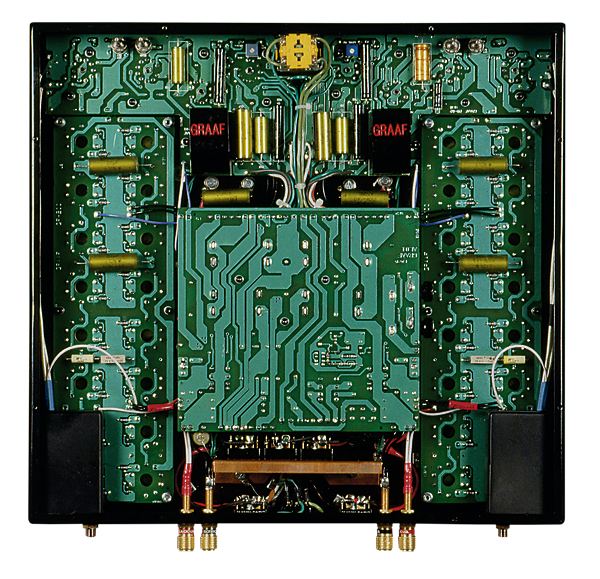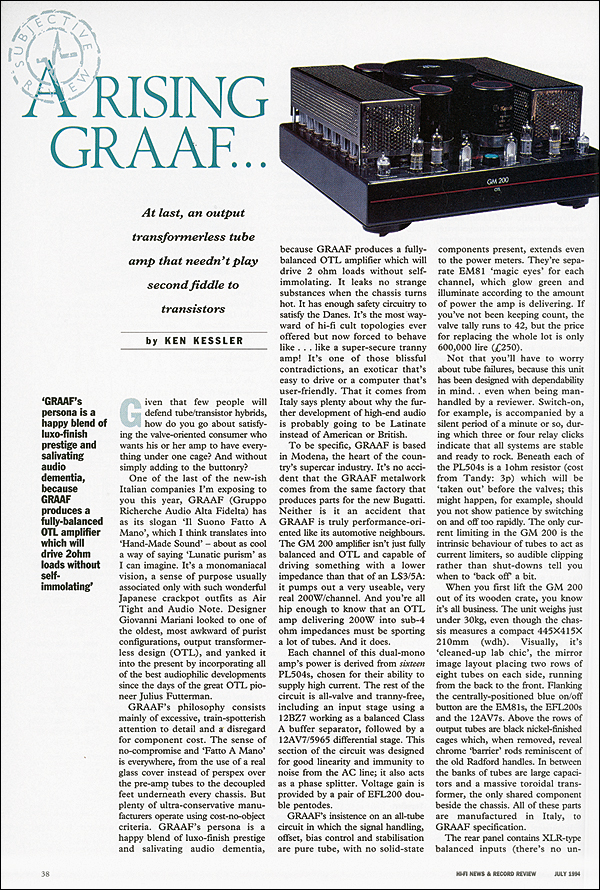A Rising GRAFF

 At last, an output transformerless tube amplifier that needn't play second fiddle to transistors, says Ken Kessler, as he hears the GM 200
At last, an output transformerless tube amplifier that needn't play second fiddle to transistors, says Ken Kessler, as he hears the GM 200
Given that few people will defend tube/transistor hybrids, how do you go about satisfying the valve-oriented consumer who wants his or her amp to have everything under one cage? And without simply adding to the buttonry? Italian company GRAAF (Gruppo Richerche Audio Alta Fidelta) has as its slogan 'II Suono Fatto A Mano', which I think translates into 'Hand-Made Sound'. This is about as cool a way of saying 'Lunatic purism' as I can imagine.
It's a monomaniacal vision associated only with such wonderful Japanese crackpot outfits as Air Tight and Audio Note. Designer Giovanni Mariani looked to one of the oldest, most awkward of purist configurations, output transformerless design (OTL), and yanked it into the present by using all of the best developments since the days of the great OTL pioneer Julius Futterman. GRAAF's philosophy consists mainly of train-spotterish, excessive attention to detail and a disregard for component cost.

Glass Ceiling
The sense of no-compromise and 'Fatto A Mano' is everywhere, from the use of a real glass cover instead of Perspex over the preamp tubes to the decoupled feet underneath every chassis. But plenty of ultra-conservative makers operate using cost-no-object criteria. GRAAF's persona is a happy blend of luxo-finish prestige and salivating audio dementia, because GRAAF produces a fully-balanced OTL amplifier which will drive 2ohm loads without self- immolating. It leaks no strange substances when the chassis turns hot. It has enough safety circuitry to satisfy the Danes. It's the most wayward of hi-fi cult topologies ever offered but now forced to behave like... like a super-secure tranny amp!
This amp is one of those blissful contradictions. It's akin to an exotic car that's easy to drive or a computer that's user-friendly. The fact that it comes from Italy says plenty about why the further development of high-end audio is probably going to be Latinate instead of American or British.
Super Sixteen
To be specific, GRAAF is based in Modena, the heart of the country's supercar industry. It's no accident that the GRAAF metalwork comes from the same factory that produces parts for the new Bugatti. Neither is it an accident that GRAAF is truly performance-oriented like its automotive neighbours. The GM 200 isn't just fully balanced and OTL and capable of driving something with a lower impedance than that of an LS3/5A: it pumps out a very useable, very real 200W per channel. And you're all hip enough to know that an OTL amp delivering 200W into sub-4ohm impedances must be sporting a lot of tubes. And it does.

Each channel of this dual-mono design's power is derived from 16 PL504 valves, chosen for their ability to supply high current. The rest of the circuit is all-tube and tranny-free, including an input stage using a 12BZ7 working as a balanced Class A buffer separator, followed by a 12AV7/5965 differential stage.
This section of the circuit was designed for good linearity and immunity to noise from the AC line and it also acts as a phase splitter. Voltage gain is provided by a pair of EFL200 double pentodes.
Private Eyes
GRAAF's insistence on an all-tube circuit in which the signal handling, offset, bias control and stabilisation are pure tube, with no solid-state components present, extends even to the power meters. They're separate EM81 'magic eyes' for each channel, which glow green and illuminate according to the amount of power the amp is delivering. If you've not been keeping count, the valve tally runs to 42, but the price for replacing the whole lot is only £250.
Not that you'll have to worry about tube failures, because this unit has been designed with dependability in mind… even when being manhandled by a reviewer. Switch-on, for example, is accompanied by a silent period of a minute or so, during which three or four relay clicks indicate that all systems are stable and ready to rock.

Beneath each of the PL504s is a 1ohm resistor (cost from Tandy: 3p) which will be 'taken out' before the valves. This might happen, for example, should you not show patience by switching the amp on and off too rapidly. The only current limiting in the GM 200 is the intrinsic behaviour of tubes to act as current limiters, so audible clipping rather than shut-downs tell you when to 'back off' a bit.
Nickel Defence
When you first lift the GW 200 out of its wooden crate, you know it's all business. The unit weighs just under 30kg, even though the chassis measures a compact 445x210x415mm (whd). Visually, it's 'cleaned-up lab chic', the mirror image layout placing two rows of eight tubes on each side, running from the back to the front. Flanking the centrally positioned blue on/off button are the EM81s, the EFL200s and the 12AV7s. Above the rows of output tubes are black nickel-finished cages which, when removed, reveal chrome 'barrier' rods reminiscent of the old Radford handles. In between the banks of tubes are large capacitors and a massive toroidal transformer, the only shared component beside the chassis. All parts are manufactured in Italy, to GRAAF's specification.
























































